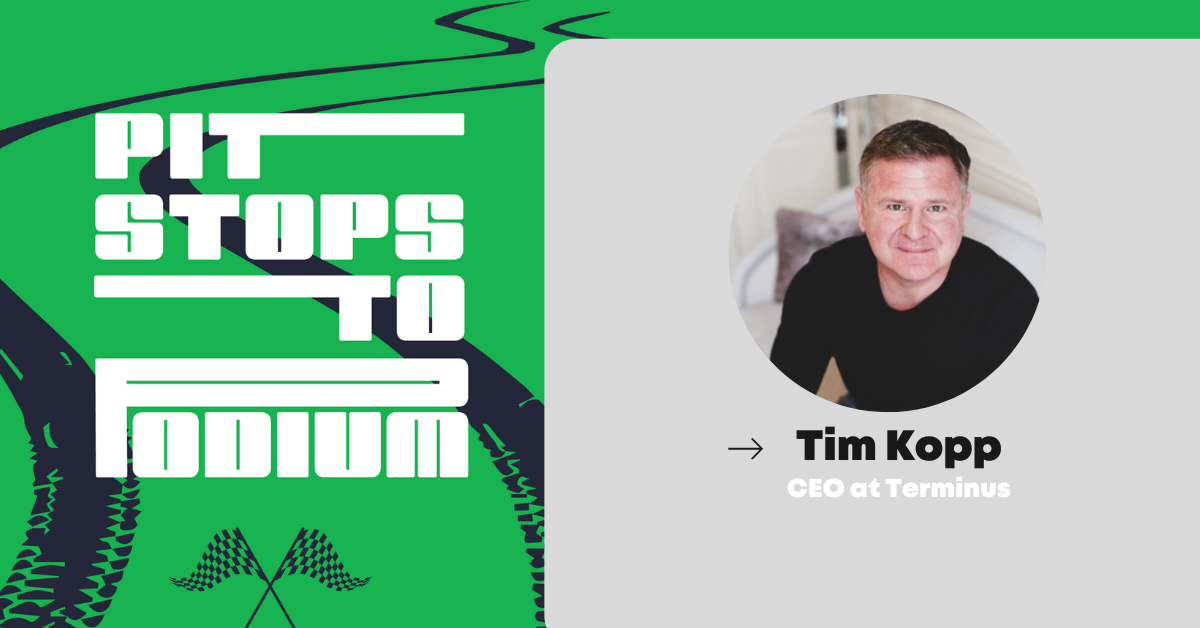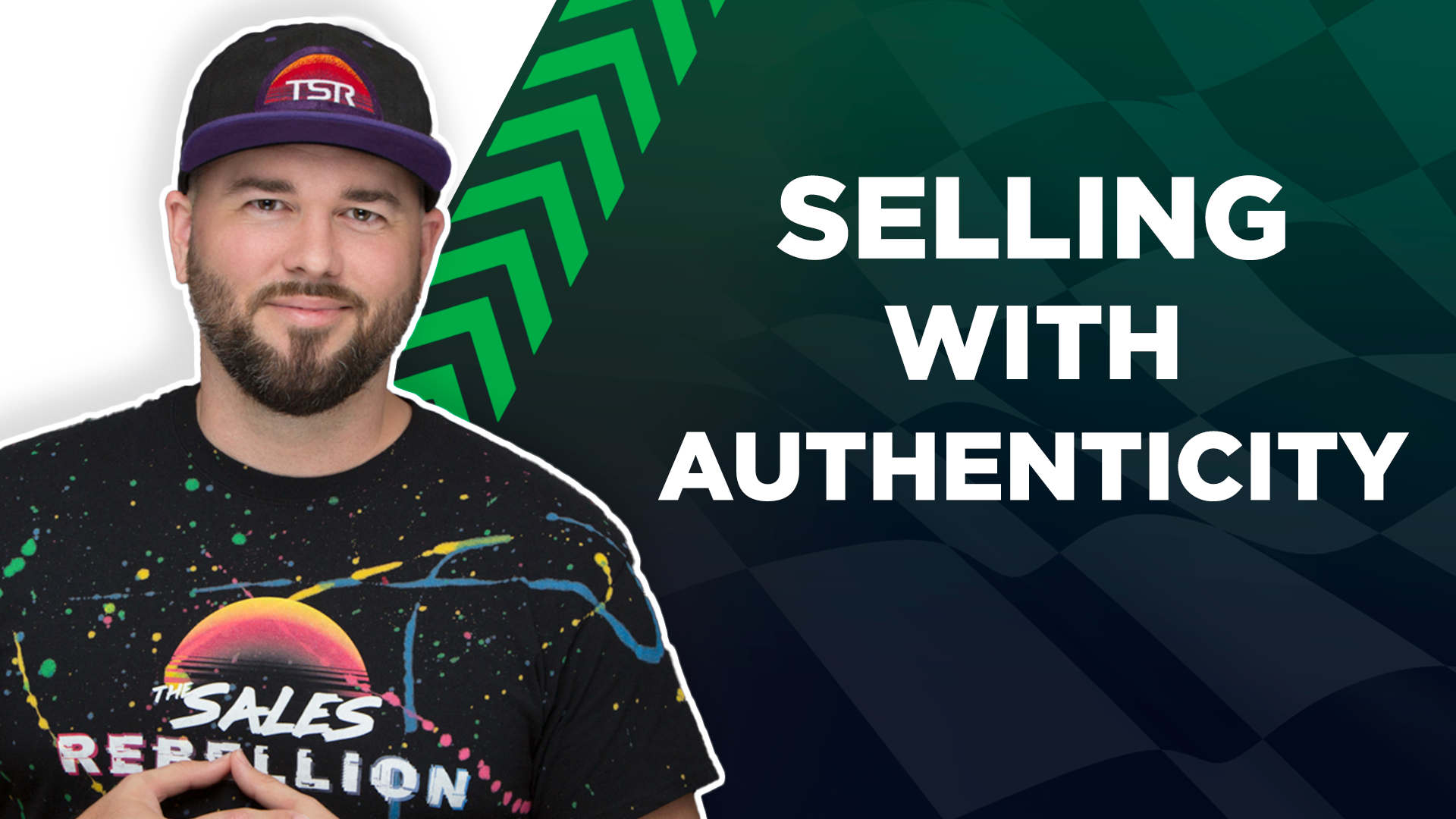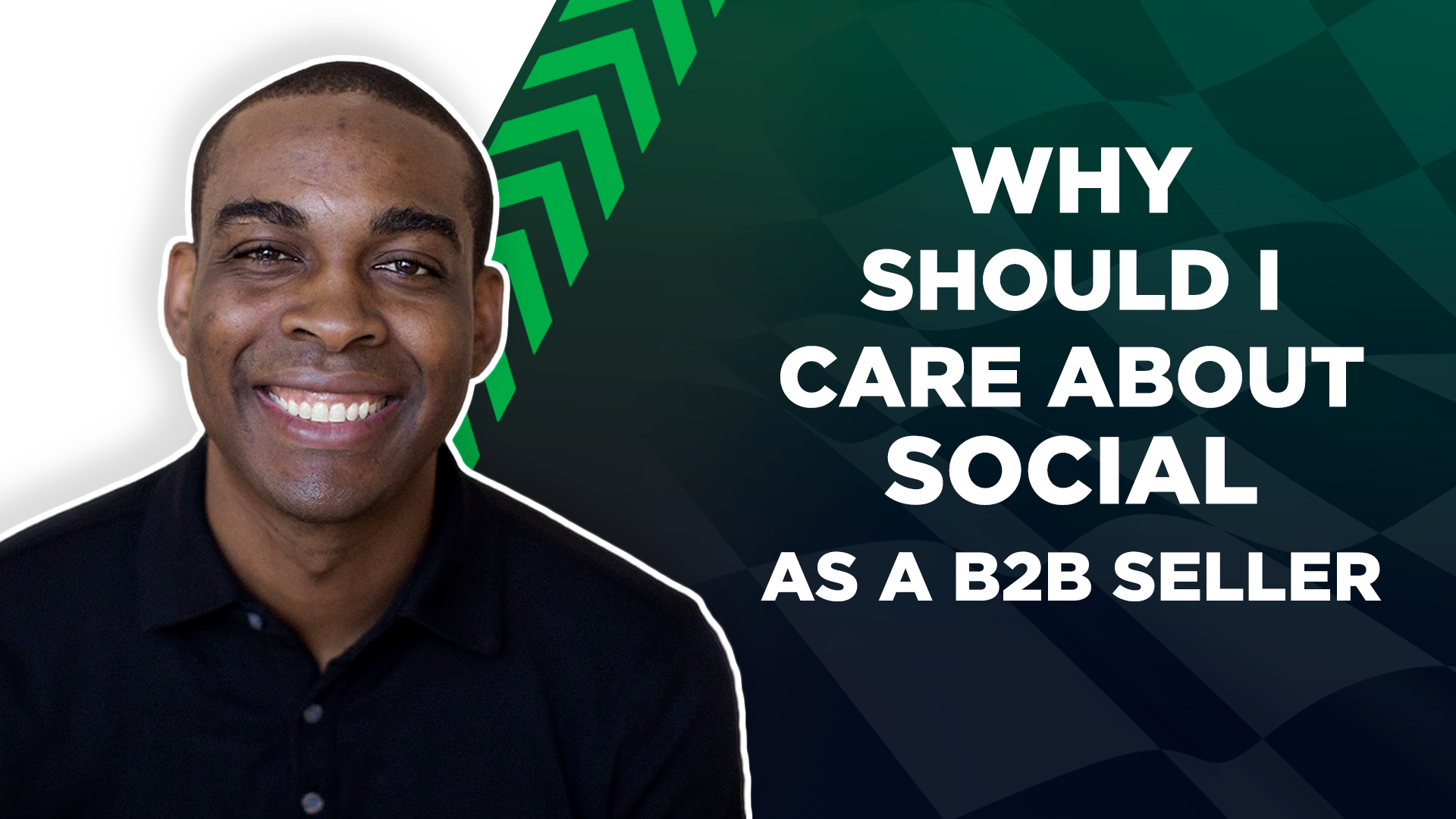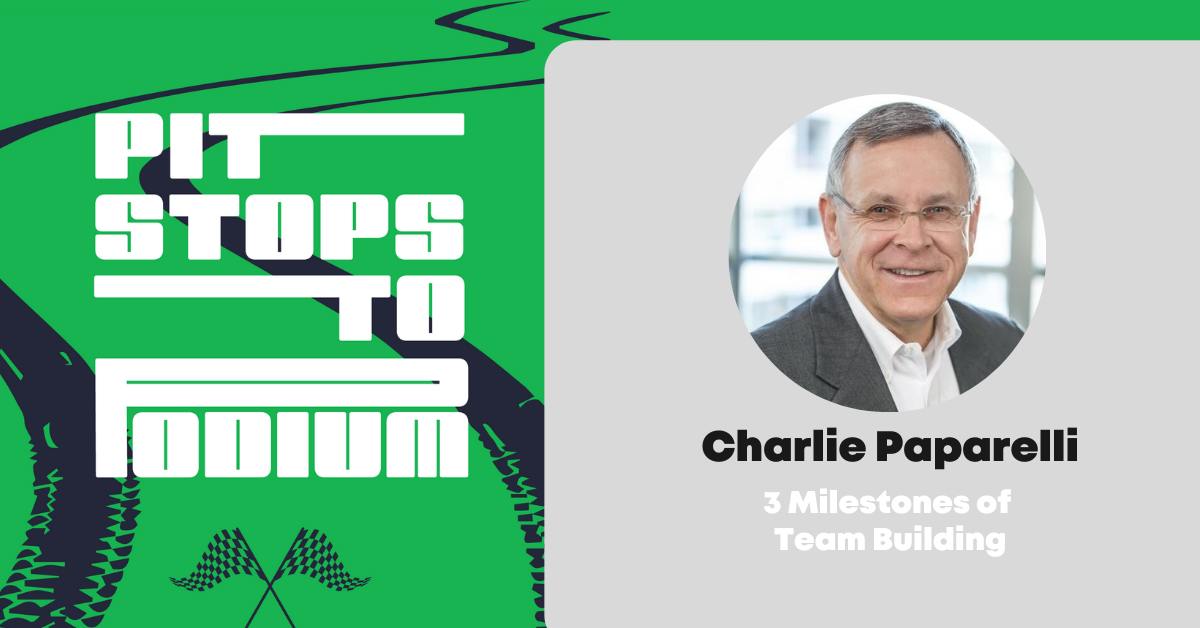
Podcast Pit Stop: Tim Kopp on The Most Underrated Retention Metric for B2B SaaS
“The greater the NRR, the quicker companies can scale.”
Tim Kopp, the CEO of Terminus, opens the "playbook" that Terminus has used to improve their retention rate by more than 30 points over just two quarters. Terminus is the leading ABM platform that powers high-performing go-to-market teams.
So, what goes into increasing NRR? Listen to how Tim and Terminus raised the NRR bar through three pillars - prioritizing people over products, putting retention into the framework of processes, and “last, but not least,” setting product offerings to better serve customers in the long run.
Most importantly, don’t miss “Crew Chief” Tim Kopp’s last surprising and caring takeaway he adds in at the end of the conversation! It's what we all need to hear.
The 3 "P" Playbook
People: "People are everything...the race get's lost in the baton handoffs. Rarely do you lose running in a straight line, it's all in the handoffs."
Through the Terminus Lense: "One of the biggest and most impactful changes we made was to move new business, retention and account management all under our chief revenue officer."
Process: "I would encourage everybody who's listening right now, think of yourself as customer zero and walk me through the entire onboarding process. How easy is it? How fast can you get somebody up and running?
And I think the number one, most statistically significant thing to determine if somebody's going to renew a year from now is what happens in the first 30 days."
Through the Terminus Lense: We've actually renamed all of client success, the client experience, because you have to design the entire thing to be an experience from the moment somebody starts that onboarding all the way through the customer journey.
Product: "If you really want to think about net revenue retention, how are you going to do that if you only have one product? If you only have one thing to sell, it's a lot more difficult. When you have multiple things, when you look at most successful B2B SaaS companies today, what they've done is they go wide and they have multiple things that you're able to sell."
Through the Terminus Lense: We started with ads...but we also have a product called Sigstr which is email signature marketing...And then the third thing we have, we've used both innovation and product acquisitions....so it's kind of one consolidated platform, but with piece parts.
Full Transcript
BT: Hey, everybody. Welcome to "Pit Stops to Podium," the RevPartner's podcast, where we talk to execs who have competed and won, taking their companies from high growth to high scale. Well, my name is Brendan Tolleson. I am the co-founder and CEO of RevPartners and I'm delighted to have with me today Tim Kopp, the chairman and CEO of Terminus. Welcome Tim.
TK: Hey, good. Thankful to be here. Speaking my language with the podium and the pit stops with the Indy 500 coming up here, so ...
BT: That's right. You're in Indianapolis. That's great.
TK: Yeah, yeah.
BT: Well, Tim, before we dive in, I'd love to give you an opportunity to inform our audience of who Terminus is in the marketplace.
TK: Terminus is the leader in account-based marketing. And what we do is we help companies move from a lead-based view of the world to an account-based view and to take action and segmentation and counter-intelligence with all of their customers in an account-based view cross-platform. So, it's been a lot of fun. We're building a great teaand having a lot of fun.
BT: Yeah. And for the audience, if you're familiar with the "flip the funnel" concept, that is Terminus. Well, Tim, before we get into the big idea today, I'd love for our audience to get to know a little bit more about you. And so what we do with our guests is kind of have three fun facts. So, what should our audience know about you as an individual?
TK: Yeah, I'm driven. I love to win and I love to build great teams, but I'm just super proud of my family and the personal side of what I'm doing as well. So what to know about me is I've been married to my high school sweetheart now for 26 years, which is pretty awesome. Have a couple, I don't feel old enough, but here it's happened. I've got a couple of kids in college. One about to get married. And I've been doing this kind of high-tech growth thing for awhile. And so it was previously at ExactTarget. And then, after we got bought by Salesforce and took the company public and been doing a lot of early stage angel investing along the way too.
BT: So I hear you saying, is you have a bit of a side gig in addition to running a company? That's pretty impressive.
TK: Yeah. You know, you gotta keep an active mind, right? Always be learning. So, I was very, very fortunate to get involved early with a couple of companies like G2 Crowd, where I'm still on the board and then a couple of others, but VCs talk about this thing called pattern matching or pattern recognition. And so it's been awesome to go and run a company and go deep, but getting the fact pattern across a couple of dozen other companies where you learn and you figure out where is their business growing, what are some of the mistakes they've made, what have they got right? And then be able to reapply it is pretty coolSo I get the breadth and depth.
BT: That's great. Well, I think that's a great segue into the big idea. Tim, I wanted to have you on the podcast because you recently published an article in TechCrunch talking about this. I don't want to call it new, but it's becoming an
emerging topic around NRR, and why it is the most underrated SaaS metric for how companies can improve retention. And so before we get into kind of those three key components within NRR, maybe just let's start with defining what NRR
is for our audience.
TK: Yeah, sure. NRR is Net Revenue Retention. And so what we talk about is there's a gross number of customers that you might retain. And let's say you renew on a logo basis, 85 out of a 100 customers. And then on a downward count, you look at that as it's called gross revenue retention. Net would be on a dollar basis. So how many of your products they buy across multiple product lines. And then just thinking about it more from a dollar standpoint of net revenue retention.
BT: It's a nice way to simplify it. Because I feel like in the SaaS world, there are a multitude of
ways of looking at retention, but this gets to kind of that not only the fundamentals, but what's most important as it relates to retention. So let's get into some of the, you know, as you think about NRR, there are kind of three different areas that you look at. And so you look at people, process, and product. I love to kind of frame that as, how are you able to achieve that 30 point gain at Terminus in two quarters with that framework? So let's use that playbook and let's start with people.
TK: Yeah. People are everything. Software has a lot of this, but at the end of the day, when you're buying software, you're buying anything. Even when you buy a car, you're buying it from a person. So you're believing in that experience, you're buying from a person and so people are everything. And so what we did is we created an experience called Terminus 360, where instead of being siloed across the company, we now bring basically a five person team into every account. So it's your digital media manager helps you optimize media or it's your account manager, might be your sales person, a services person. We bring them all together because where I find the race gets lost, back to your kind of analogy, is on baton handoffs. Rarely do you lose running in a straight line, it's all in the handoff. So when you bring everybody together on both sides, you kick it off very, very important. And the second thing that we did around that is, and this is kind of where it blends people and process, I guess to a certain extent and kind of bleeding into process a bit is our CRO, our head of revenue owns 50% of his bonus plan and comp plan and compensation is based on retention and the other 50% on new business growth. So it makes no sense to, and some companies, I say it's growth at all costs. So you go and acquire customers, you can't retain. So it should be only about really knowing who is your ICP, who is the right fit customer, particularly when you're selling to marketers, you could just throw around a lot of product and sell it. So the most important part is selling it to customers that you can retain and have longer lasting relationships with. So on the people side, I would say Tim Satterwhite, who's our CRO and he's dynamite, and the rest of his team, their client success and CS and services rolls into our whole go-to-market team. And I believe that is the modern version of go-to-market or client success services and sales should all roll into the same leader.
BT: I love that. It's having a long-term view with also a short-term focus and making sure that the people that are responsible for it in this case, the CRO is motivated and incentivized to ensure that not only bringing in the right accounts, but also making sure that you have a team in place to delight that customer and not only retain them, but hopefully expand that relationship over time.
TK: Exactly. Right.
BT: Anything else on the process side that you'd like to call, outside of how you've structured the organization?
TK: Yeah. You know, we try to think about a number of things. And one of the first things I did as CEO is just walk me through the entire process a customer would go through on onboarding. I want to see what it looks like. And then back to the handoff part, companies don't do this on purpose, but sometimes the larger you get, the more complex you might make it. So thinking about, I would encourage everybody who's listening right now, think of yourself as customer zero and walk me through the entire onboarding process. How easy is it? How fast can you get somebody up and running?
And I think the number one, most statistically significant thing to determine if somebody's going to renew a year from now is what happens in the first 30 days. And if you think about it, it's the same thing as a hotel or a restaurant or anything. If you go into a restaurant and you have reservations, but for some reason they make you wait 20 minutes, then it takes 10 minutes for a server to come in. No matter what, you could get a five star steak, no matter what happens, the rest of the meal, you're already done. Like I'm checked out, I'm done. You walk into a hotel... Think about any buying experience in B2C, it's the same thing in B2B. And so you have to nail your product. And it sounds so obvious, but we don't think about it. We've actually renamed all of client success, the client experience, because you have to design the entire thing to be an experience from the moment somebody starts that onboarding all the way through the customer journey. I just find that it's so broken in B2B companies.
BT: I think it even speaks to how you wanted to structure this podcast where the three bullets around NRR, product is actually the last, and that people and process are the first, which gets to this idea of how do you not only have a great team, but ultimately having that service component to ensure that that product not only works, but that people had that
experience in the onboarding phase, which is commendable. Cause oftentimes what you see in a software world is that products can solve everything. And that's clearly not the case in terms of how you're describing it. So I commend you for that. You don't usually hear that with someone in the CEO seat of a software company.
TK: Well, I think it's because I've been selling to marketers for so long and most marketers end up, they have 10 or 12 different solutions and they're not trying to buy a piece of software. They're like, "Tell me what to do. I want a business outcome." If anybody thinks they can buy a piece of technology and it's going to solve all of your problems or all the world's problems, I don't know how that works. You need the guidance, particularly in a new category, like ABM, like a lot of people don't even know what account-based marketing is yet. So just like, tell me what to do. Tell me where to start. It's not like you just turn it over and you go. So, thank you. But the last part really is product. And if you don't have a product that works, if you don't have a product that delivers on the outcomes, you will not get retention. So product is a huge, so it's kind of like last but not least kind of thing. Your product has to work, period. You have to deliver on your promise. But the second part of it is if you really want to think about net revenue retention, how are you going to do that if you only have one product? If you only have one thing to sell, it's a lot more difficult. When you have multiple things, when you look at most successful B2B SaaS companies today, what they've done is they go wide and they have multiple things that you're able to sell. So you kind of stick the landing with the first product. You make that work, but then you show them a path to value on how they can continue to compound it with other products. And it's a win-win. So getting to a multi-product solution, I think is a big part of this.
BT: How's that look like from a Terminus experience?
TK: So for us we started with ads and we were an ad company. If you went back 18 months ago, we had one thing to
sell you, which is ads. And if there was a way to drive NRR, it would be buy more ads from us or give us to another, maybe sell us to refer us to another division inside of your company. Today, now we've been able to bundle that. So we have ads, but we also have a product called Sigstr which is email signature marketing. And that becomes a common part of your platform. And then the more first party data you get from email, the better it makes your ad serving the better it makes the whole thing work. We have chat as part of our platform. People want chat natively integrated into an account-based platform. Then when you're able to again, get that first party data. When somebody is on your site, you get to know them better. It makes the whole platform better. It makes you more intelligently serve ads. And then the third thing we have, we've used both innovation and product acquisitions. The way we've done this, we acquired a company called GrowFlare, which helps you. Many of the companies I consult with and work with don't know who their ICP is, or your ideal customer profile. And you also act like it's a static thing. Like once I know who my ICP is, that's who it is forever. It doesn't work that way. It's extremely dynamic and fluid. You don't just nail that. So GrowFlare pulls together psychographic data with demographic data to help you figure out your best fit accounts. Now you're looking at
an end-to-end platform. Help me figure out my best fit accounts, help me target and engage with them with ads, chat, and email, and then pull it all back together and show me what the measurement is. So it's kind of one consolidated platform, but with piece parts.
BT: Love that. Well, Tim, thanks for your time today. I love learning a little bit more about not only what NRR is, but how Terminus has been able to take this framework or playbook that you just outlined in terms of people, process and product and experience that 30 point growth. If people want to engage with you or engage with Terminus, what are the practical next steps that they can take?
TK: Yeah, just look me up. You can find me on Twitter @tbkopp, shoot me a line. My email is talktotk@terminus.com. You can shoot me an email. I'd love to hear from you. Just send feedback on what you've heard here. And then my last practical tip to kind of close this out. What I've had a hard time kind of learning along the way. You have to take care of yourself so you can take care of others. And we're all so busy. COVID is bananas. The world has been bananas, and sometimes you can get spread so thin. And what I'm really working on with the summer ahead is making it the summer of simplicity. And sometimes it's as important to define what you're not going to do as what you are going to do. But for me, no matter how busy the day is, I always start with workout and fitness. I always find time to spend with my family to close out the day. And do not let yourself get so spread thin that you have no energy. That you have nothing to give back to the rest. It's the same thing as when you're on a plane, they say, put the oxygen mask on yourself first, before you give it to others. And we can forget that in a business context. So even if you forget all the business stuff, I would ask that you keep that as your one takeaway, take good care of yourself.
BT: Thank you. That was a very applicable to me right now. And I'm sure it is for the rest of our audience. And you've obviously seen both sides of that. And yeah, I can't say enough about how helpful that was for me. So thank you.
TK: Good. You bet. Take good care.
Want to hear from more industry experts?
Come check out the full Pit Stops to Podium podcast repository!



